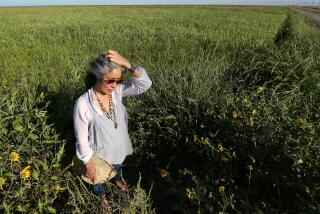Dirt : Farming the Peninsula
On James Ishibashi’s farm on the Palos Verdes Peninsula, gnats swarm around anyone who stands still. A fist-sized songbird called the gnatcatcher ordinarily thins out the insects, but coastal development has driven away many of the birds, just as it has driven away almost all of the Japanese American farmers from this area.
“I’m the gnatcatcher now,” Ishibashi says with a chuckle, looking out over his eight-acre Rancho Palos Verdes plot, which is surrounded by the Pacific Ocean, sun-seared hills and condominiums. For the past five years, he has leased this land from the Palos Verdes Unified School District--the latest plot in decades of farming--and has grown sweet peas, narcissus, Iceland poppies, strawberries, string beans, tomatoes, carrots, beets, bell peppers, lettuce and some basil, which customers at his roadside stand demand.
At 76, Ishibashi looks like a lifelong farmer. He always wears a cap over his close-cropped graying hair, and his skin, sun-darkened to a deep brown and hardened by the ocean breeze, hangs tightly on his angular face, stretching when he laughs, which he does often. Because the cartilage in his right knee is worn, he walks with a limp. He still rises everyday before sunrise, beginning each morning with a prayer, and is out in his fields by daybreak. He repairs water leaks and drives his tractor, while his two field hands do the heavy labor, lifting bags of fertilizer and picking string beans. When the picking is done, he directs them to pull weeds with the functional Spanish he has taught himself: “Acabo? Limpia yerbas alli.”
One afternoon recently, while making his way gingerly over the rocky adobe soil to inspect rows of carrots and bell peppers, Ishibashi tells me he can’t imagine retiring. “I want to stay out here,” he says. “You can meditate and you can talk to yourself. Nobody will hear you.”
When a cousin retired a few years back, he left only Ishibashi and one other Japanese American farmer on the peninsula. Gone are the days when 40 Japanese families formed a farming cooperative and worked nearly 2,000 leased acres (Japanese were prohibited from owning land) of the Palos Verdes hills. Ishibashi’s father, Tomizo, was one of the first to arrive to the peninsula in 1910. Ishibashi, who grew up with six siblings in a farmhouse near Portuguese Bend (1 1/2 miles from his current farmland), was 23 when FBI agents came looking for anything subversive--guns, cameras, flashlights.
Pearl Harbor had been bombed and all Japanese in the United States were suspect. The agents popped off the hubcaps on his father’s ’36 Ford but found nothing. In the spring of 1942, with crops ready for harvest, half of Ishibashi’s family was evacuated to an internment camp in Arizona, while Ishibashi and the rest became contract laborers in Utah. There, he met his wife, Annie, while growing potatoes.
After a tour of service with the armies of occupation in Germany and Japan, he returned to the peninsula, along with about six other Japanese American farmers. He’s been there ever since, raising two children, farming different lots, watching the spread of homes--and, by his admission, making a good living.
Annie, a woman beloved in Rancho Palos Verdes as the “flower lady” of Annie’s Stand, died of cancer in 1992. Now Ishibashi’s daughter runs the whitewashed stand--the last of its kind on the peninsula--whose sign reads “Deliciously Yours” from one direction and “Beautifully Yours” from the other.
“Some people ask me why I don’t go off and travel,” he says. “But I take one day off every week, so I get 52 days of vacation. I feel all right. I’ve got to feel all right. Otherwise, who’s going to do the work?”
One morning, a waning moon lights the dark field, and the sky blushes with its first light over the ramparts of condominiums. The faint smell of anise hangs in the sea-cooled air. Ishibashi looks out over the gray-blue Pacific. “You notice how peaceful it is out here?” he says. “Each individual has a place of freedom. That is if you can find a place. And this is where I’ve found it.”
More to Read
Sign up for The Wild
We’ll help you find the best places to hike, bike and run, as well as the perfect silent spots for meditation and yoga.
You may occasionally receive promotional content from the Los Angeles Times.





